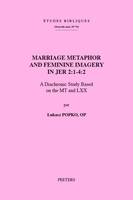- EAN13
- 9789042934238
- ISBN
- 978-90-429-3423-8
- Éditeur
- PEETERS
- Date de publication
- 31/12/2015
- Collection
- ETUDES BIBLIQUE (70)
- Dimensions
- 22 x 18 cm
- Poids
- 1030 g
- Langue
- français
- Fiches UNIMARC
- S'identifier
Marriage Metaphor and Feminine Imagery in Jer 2:1-4:2
A Diachronic Study Based on the MT and LXX
Popko L.
Peeters
Etudes Biblique
Offres
Jer 2:1-4:2 is a locus classicus of the prophetic marriage metaphor, which
describes the turbulent relationship between Israel and her God. The
literary form of the Book of Jeremiah preserved in the Septuagint (LXX)
invites a new diachronic study of this text. The systematic, comparative
study of the LXX and the Hebrew (MT) makes up a substantial part of the
present book (ca. 200 pages). The redaction-critical reconstruction
follows the literary form thus retrieved. The edition preserved in the MT
introduces the marriage metaphor where the earlier text used general
feminine imagery, or suggested rather a filial relationship. The
inspiration for the revision came from the Books of Hosea and Ezekiel. The
interpretations specific to the translator of the LXX do not point to any
coherent agenda. The earliest passages clearly applying the marriage
metaphor were introduced at the latest stages of the redaction history.
Their results demonstrate the growing importance of the marriage metaphor,
as well as the ancient editors’ conviction about the unity and
interconnection of the books which make up the Bible. Jr 2,1-4,2 est un
locus classicus de la métaphore prophétique du mariage pour décrire la
relation tumultueuse entre Israël et son Dieu. La forme littéraire du
livre de Jérémie dont témoigne la Septante (LXX) invite à reprendre, à
frais nouveaux, l’étude diachronique de ce texte. L’étude comparée,
systématique, de la LXX et du TM forme la partie importante du livre (ca.
200 pages). La critique rédactionnelle qui suit se fonde sur les résultats
obtenus par cette étude. L’édition conservée par le TM a introduit la
métaphore du mariage là où le texte plus ancien appliquait des images
féminines plus générales, ou suggérait plutôt une relation filiale.
L’inspiration de ces révisions est venue des Livres d’Osée et d’Ézéchiel.
Les interprétations propres au traducteur de la LXX ne montrent pas de
plan cohérent. Le passage le plus ancien employant clairement la métaphore
du mariage a été introduit dans les dernières phases de l’histoire de la
rédaction. Ces résultats montrent l’importance croissante de la métaphore
du mariage, ainsi que la conviction des éditeurs anciens sur l’unité et
l’interconnexion des livres qui composent la Bible.
describes the turbulent relationship between Israel and her God. The
literary form of the Book of Jeremiah preserved in the Septuagint (LXX)
invites a new diachronic study of this text. The systematic, comparative
study of the LXX and the Hebrew (MT) makes up a substantial part of the
present book (ca. 200 pages). The redaction-critical reconstruction
follows the literary form thus retrieved. The edition preserved in the MT
introduces the marriage metaphor where the earlier text used general
feminine imagery, or suggested rather a filial relationship. The
inspiration for the revision came from the Books of Hosea and Ezekiel. The
interpretations specific to the translator of the LXX do not point to any
coherent agenda. The earliest passages clearly applying the marriage
metaphor were introduced at the latest stages of the redaction history.
Their results demonstrate the growing importance of the marriage metaphor,
as well as the ancient editors’ conviction about the unity and
interconnection of the books which make up the Bible. Jr 2,1-4,2 est un
locus classicus de la métaphore prophétique du mariage pour décrire la
relation tumultueuse entre Israël et son Dieu. La forme littéraire du
livre de Jérémie dont témoigne la Septante (LXX) invite à reprendre, à
frais nouveaux, l’étude diachronique de ce texte. L’étude comparée,
systématique, de la LXX et du TM forme la partie importante du livre (ca.
200 pages). La critique rédactionnelle qui suit se fonde sur les résultats
obtenus par cette étude. L’édition conservée par le TM a introduit la
métaphore du mariage là où le texte plus ancien appliquait des images
féminines plus générales, ou suggérait plutôt une relation filiale.
L’inspiration de ces révisions est venue des Livres d’Osée et d’Ézéchiel.
Les interprétations propres au traducteur de la LXX ne montrent pas de
plan cohérent. Le passage le plus ancien employant clairement la métaphore
du mariage a été introduit dans les dernières phases de l’histoire de la
rédaction. Ces résultats montrent l’importance croissante de la métaphore
du mariage, ainsi que la conviction des éditeurs anciens sur l’unité et
l’interconnexion des livres qui composent la Bible.
S'identifier pour envoyer des commentaires.

